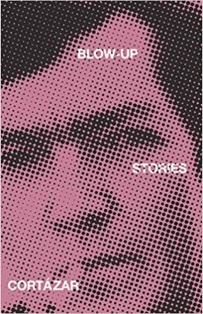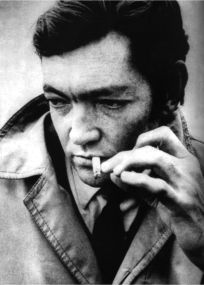Blow-Up
(originally The Devil's Drool): film vs. story
The movie version of
Blow-Up marks the beginning of Antonioni's decline as a filmmaker. The messy
narrative with its impotent. symbolisms and pop culture asides do no favors for
either himself or Cortazar, although sometimes they almost succeed. Only the
central metaphor of the photographer trying to unravel a mystery via a series
of blow ups of a man in gray remains, and for Antonioni this man is a body,
possibly the victim of a murder, not a mysterious man in a car who sits
watching a woman and a youth on the tip of an island in the Seine, as in
Cortazar's story. While he seems to have understood the mystical possibilities
inherent in the story, Antonioni was under the influence of the absurdist style
of 50's/60's theatre, in particular Samuel Beckett and his acolyte Harold
Pinter. While Tonino Guerro, a seasoned Italian screenwriter is listed as the
main writer along with Antonioni, the absurdist stage trickery and Platonic
logic is all too evident in the perceptual conundrum presented by the tennis
game with no ball. You could argue that it repeats the lesson of the "photo
blow-up" or dismiss it as redundant and distracting. While enigma is central to
the surrealist way of doing business, as a closing scene it does nothing to
advance our understanding of what went down in the park.
The original title of
the Cortazar story was The Devil's Drool (Las Babas del Diablo) and
draws us closer to the suspicion that 'the man in gray' (gray hat) is a
pedophile who is using the woman as a procuress to snare the youth for a
threesome or for his enjoyment alone. Yet you just don't know. He might be the
woman's husband, tolerating her desire to seduce a toyboy... or, for that
matter, the whole situation could be sexually innocent. The youth might be the
woman's son... or their son, perhaps estranged, and the event is an attempted
reconciliation. The amateur photographer's perception is merely a process of
understanding... or misunderstanding. The suspicion is that a crime is being
committed, and, like a detective, the photographer is driven by a need to
understand it, the why and the wherefore, and to do this, he needs to get
closer to the mise en scene. Thus he enlarges the photograph to the point of
abstraction and finds himself further away from the truth, but closer to
belief. There's an element of madness in Michel's narrative, as if he is
replaying an event from a former life, and his blow-up is a Rorschach blot
excavating his despair, his guilt, his impotency.
'The photo had been
taken, the time had run out, gone; we were so far from one another, the abusive
act had certainly taken place, the tears already shed, and the rest conjecture
and sorrow. All at once the order was inverted, they were alive, moving, they
were deciding and had decided, they were going to their future; and I on this
side, prisoner of another time, in a room on the fifth floor, to not know who
they were, that woman, that man, and that boy, to be only the lens of my
camera, something fixed, rigid, incapable of intervention.'
This is quite
different from Antonioni's version of the same scene, the same metaphor. For
Antonioni's photog there is no triangle of sinister intent going on in the
park, although something sinister emerges later. His photographer, Thomas, is a
professional (modelled on the well-known London fashion photographer David
Bailey) and he's wandering in the park with his camera, happens to photograph a
woman and her male lover frolicing. The woman confronts the photog, demands the
film, but to no avail. The discovery of the body in the border bushes is an
accident of the blow-ups, a surprise, not something he does to confirm a
suspicion -- as in Cortazar's story -- and in fact might be a hallucination
created by the developing process. First the blow-ups reveal a man with a gun
in the bushes, then another, the body, presumably the lover. The photographer
returns to the park at dusk but finds no body. So there is no solution to the
mystery, only a confirmation of unreality. It should be noted that this
arthouse film was very popular at the time (1967) as its mix of pop culture
characters and arcane imagery appealed to the psychedelic preferences of a
generation quite willing to believe that "nothing is real'.
Anyone reading
Cortázar's story after seeing Antonioni's film would be confused, and
see little resemblance, except perhaps in the metaphysical outreach. David
Hemmings, who played Thomas the photographer, says the first script he was
given was 16 pages entitled
'A Girl, a Photographer,
and a Beautiful April Morning which raises the possibility that
Cortázar's story was perhaps a later addition to the project. By the
time he made Blow-Up, Antonioni had become committed to the auteur idea of
improvising films on the fly. Godard was doing it, so why not him? Often the
literary property was just an excuse to find financial backing, although in
Antonioni's case he did have some use for Cortázar's plot, if not the
full cast.
Both artists share a
sympathy for an occult solution to the mystery of life. Both use the geometry
of art to explore their themes. Both use the surrealist possibility of
conscious and unconscious action. But Antonioni's culture is the art gallery,
whereas Cortázar's is the library. The difference? Exterior versus
interior perceptual processing. With Antonioni, there's always a melancholy
sense of something lost -- and you see this in many of his films -- which is
why he probably identified with Cortázar, who shares the same
sensibility. In both artists, the autobiographical element is always close to
the surface, regardless of the disguise.
'Roberto Michel,
French-Chilean, translator and in his spare time an amateur photographer...'
Obviously Antonioni could identify with being a photographer. As for
Cortazar... he was Belgian-Argentinian and a translator.
'I don’t like
autobiography. I will never write my memoirs. Autobiographies of others
interest me, of course, but not my own.' (Paris Review)
You can laugh this
off, of course, because what is his famous novel Hopscotch (1963/66) but a
writer's journal jazzed up as fiction: '...here I am a Frenchified Argentinian
(horror of horrors), already beyond the adolescent vogue, the cool, with an
Etes-vous fous? of Rene Crevel anachronistically in my hands, with the
whole body of surrealism in my memory, with the mark of Antonin Artaud in my
pelvis, the Ionisations of Edgar Varese in my ears, with Picasso in my eyes
(but I seem to be a Mondrian, at least that's what I've been told).' [Julio
Cortázar, 21, Hopscotch]
|

|








